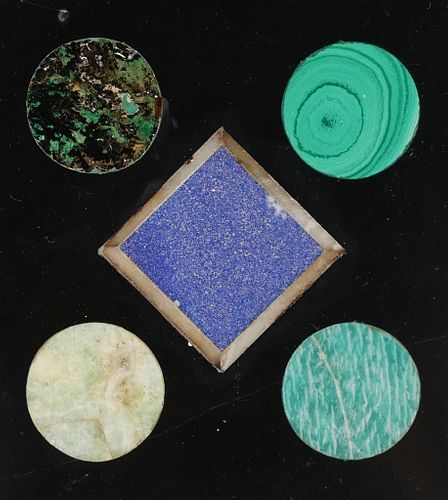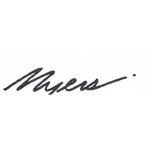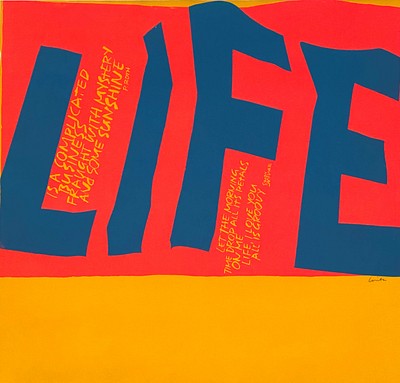Richard Blow (American, 1904-1983) Montici Pietra Dura 1969 Plaque
Two ways to bid:
- Leave a max absentee bid and the platform will bid on your behalf up to your maximum bid during the live auction.
- Bid live during the auction and your bids will be submitted real-time to the auctioneer.
Bid Increments
| Price | Bid Increment |
|---|---|
| $0 | $10 |
| $100 | $25 |
| $500 | $50 |
| $1,000 | $100 |
| $2,500 | $250 |
| $5,000 | $500 |
| $10,000 | $1,000 |
| $15,000 | $2,500 |
| $50,000 | $5,000 |
| $100,000 | $10,000 |
About Auction
Apr 30, 2023
Fine Art Auction - 35th Anniversary Myers Antiques auctions@myersfineart.com
- Lot Description
Richard Blow (American, 1904-1983) Montici Pietra Dura Plaque. Title - Four Circles and a Diamond. Hand-cut Italian stone pietra dura inlaid mid-century modern plaque executed in the 1960’s by Richard Blow for his Atelier in Montici Italy. The inlaid hardstone Florentine mosaic plaque is signed with the inlaid M cipher Montici mark. Inscribed Blow, Montici ‘69 on reverse. Measures 5 inches high, 4.6 inches wide. Frame measures 6.5 inches high, 6.1 inches wide. In good condition.
From Askart.com: The following is excerpted from the book FLORENTINE MOSAICS And Richard Allmand Blow Essay by Matilda Simon, Oregon State University Foundation. Richard Almond Blow (1904-1983) was born in La Salle, Illinois, the youngest of four children of George and Adele Matthiessen Blow. George Blow was the scion of a family that traces its ancestry to the Virginia House of Burgesses and further back to John Blow, 17th century English organist, composer, and teacher of Henry Purcell, English composer. George, whose wife counted several Danish whaling captains among her forebears, remained true to another Blow heritage of interest in shipping and the sea. He was an officer in the United States Navy and, at the time of the sinking of the Maine in 1898, was a lieutenant on that ship from which he was lucky enough to be rescued. Richard Blow, his sister, and two brothers spent their childhood on the family estate,Deer Park, near La Salle before going off to school. Richard attended Woodberry Forest School in Virginia and then Lawrenceville in preparation for Princeton where he studied architecture. His interest in art began early, stimulated by watching his mother who had studied art in Paris before her marriage. It was her habit to roam the estate sketching from nature, and Richard recalls following her around and making his own drawings. It is certain that his interest in nature, animals, birds, and insects began early, also, for he kept many odd pets and began collections of butterflies. When he was about fifteen or sixteen, he conceived the idea of a very large work of art, a mural that covered the inner walls of a porch that extended around three sides of the family mansion. The mural represented, in trompe l'oeil, an 18th century outdoor garden scene. Unfortunately, no efforts were made to preserve the work and it eventually succumbed to wind and weather, but descriptions of it by knowledgeable visitors have survived and it was described to this writer as perfectly enchanting and truly extraordinary opinions easy enough to accept by one fortunate enough to have seen large quantities of Blow's work in easel painting and mural decoration. During his three years of architectural studies at Princeton, Blow found free rein for his sharp sense of humor as a cartoonist for the Tiger. His inclination to art became a compelling force which took him from Princeton to the study of painting under Professor Leon Kroll at the Art Institute of Chicago. In 1926, Blow went to Europe with his older brother and recalls of this trip their descending the Seine in a canoe. In 1927, he purchased a Renaissance villa, Piazza Calda, situated on a hilltop in Santa Margherita a Montici, across the Arno from Florence. Sadly neglected by its previous owner, the house and grounds required extensive renovations. To accomplish these, Blow hired an English architect Cecil Pinsent, a man with a great feeling for and knowledge of Renaissance architecture and landscaping. Restoration of house and grounds took many years, and the ultimate result was a delightful, livable house set in terraced gardens, a tower studio, stone obelisks, a grotto, magnificent trees, and splendid views from every window and from any angle. During the very early restoration period, Blow attended the Beaux-Arts in Paris for a few months, studying with Andre Lhote. Then from late 1927 and for the half century following, Piazza Calda became his European residence and studio and eventually the birthplace of the Montici Marbles 20th century Florentine Mosaic. Until 1941, Blow lived as might be expected of an independently wealthy man and a talented artist. He traveled back and forth between Europe and the United States, painted constantly wherever he was, and exhibited work in various group shows until 1938, when he had his first one-man show at the Maynard Walker Gallery in New York. Critical notices for this show praised the artist for his free handling of the brush, his fine composition, and his use of subtle color in works variously described as nostalgic, classical, and sculptural in feeling. It is interesting to note that Blow's favorite classical artist is Piero della Francesca, and there is in his landscapes, his figure painting, and his still lifes, the same quiet, grave strength, the same perfection in perspective, the same feeling for luminosity and light, and for color. At the time of his first one-man show, perspicacious collectors began to acquire his paintings. Among these we may note the Metropolitan Museum of Art, the California Palace of the Legion of Honor, and Robert Maynard Hutchins, President of the University of Chicago. Immediately after Pearl Harbor, in line with family tradition and already a licensed airplane pilot, Blow entered the Navy as a lieutenant in the Air Arm. Overage for combat duty (he was thirty-seven), after he had completed his training at Pensacola, he ferried personnel to Europe from the Naval Flying Base near Washington. D.C., before being assigned as an instructor at the Naval Air Force Training Base at Kokomo, Indiana. Out of this assignment, which he did not particularly enjoy, came a nickname, Kokomo Joe Blow, which endures in the signature Joe on letters to relatives and close friends. After Indiana, he became Naval Attache for the Caribbean area and was stationed in the islands. Finally, he was variously posted in San Francisco, Hawaii, and the Philippines; from all these places he flew the big ones across the Pacific as far as Shanghai. When the war ended, Blow was a lieutenant commander and had flown countless missions in DC 2's, DC 4's, Army B-25's, and twin-engined Grummans. Between 1946 and 1954, when this was still a novelty, while he was in the United States he piloted a twin-engined Cessna, using as his principal base a rather woodchuck-infested private field in Dutchess County, New York. A serious automobile accident on an icy road in 1954 put an abrupt end to Blow's flying days. Immediately after the war in 1947, Blow returned to Italy to spend several months there as had been his habit. He had always been interested in Florentine Mosaics, and he now conceived the idea of setting up a workshop on his own property to revive an art form first developed by the Medici family. Villa Piazza Calda, admirably located for wartime observation and reconnaissance - it has a sweeping view across the valley of the Arno - had been occupied by the British and was the object of some attention by the Germans who clung desperately to the city of Florence and the surrounding countryside, doing considerable damage, some irreparable, to historic buildings. Fortunately, Piazza Calda escaped relatively unscathed, for it became the art of Pietre Intarziate (Pietre Dure, Florentine Mosaic) what the gardens of San Marco and the Uffizi had been during the Renaissance. Because of poor restoration and repair, lack of taste in selecting subjects for small pictures in stone,' compromise in materials used, and the addition of printers' ink or paint to make up for inferior coloration, the art of Florentine Mosaic had almost died before the advent of World War ll. . . .There seemed little room for the production of works of art that require years of apprenticeship, costly materials, and the eye of an artist to supervise basic designs and perfection in the finished product. Richard Blow believed that what this art needed he could provide. With the help of two young Italian artists, Constantino Nivola and Eva Carocci, Blow supplied modern designs and, it must be added, a great many dollars. He also suggested the use of an electric saw to reduce the time required to cut the stones. But the workers found the hand saw preferable, especially since the stones were often only three millimeters in thickness. And in the workshop at the Villa Piazza Calda, Florentine Mosaic came to life again, with the advice and stimulation provided by Lando Bartoli, then the head of the Opificio. The perfectionist requirements of Richard Blow resulted in a series of pictures of dancing girls, still lifes, Landscapes, birds, fish, animals, horses, mermaids, sea shells, flowers, fruits, guns, engines, balloons, all of them in marble and semiprecious stones. All of the pictures were worked over long and lovingly, subjected to the artist's final approval, honestly and faithfully made in the finest stones, and rejected if imperfect. When completed and accepted, each piece was marked with a tiny M stone insert as a Montici signature and signed on the back by Blow himself. The Opificio or Museo delle Pietre Dure in Florence now contains a great many of Blow's pictures, the only ones considered worthy to hang with works created before the Medici family disappeared. Other Blow pictures, boxes, obelisks, and table tops enrich the homes of wealthy collectors all over the world. The collection presented to Oregon State University demonstrates to artists and art connoisseurs why these works are unique. To have seen them created from the sketch to the final acceptance was, for this writer, a privilege, a return to another world that is vanishing so rapidly it will soon be only a distant memory, an anguished one for those who treasure individualism, craftsmanship, and the application of fine art to everyday living. Imitations of these works will be made for years, but the workshop in Santa Margherita a Montici will produce no more original designs. Richard Blow continues to paint in his studios in Italy and in New York. His pictures in stone will endure for centuries. For this we must be grateful. Matila Simon.
From TheNewYorkTimes.com: Richard Blow, a painter known for his revival of intarsia - a Florentine mosaic technique - died of a stroke in New York Tuesday. He was 79 years old. Mr. Blow's work reflected his experience in Italy, where he bought a villa early in his career. His figurative paintings depicted castles and landscapes and other classical motifs and themes. After World War II, he redeveloped intarsia. While his oil paintings were exhibited under his own name, his mosaics were shown under the name Montici. He is survived by two sons, David Jay and Mark; four nephews and a former wife, Marya Mannes.Condition
Condition is listed in the description
- Shipping Info
-
All shipping arrangements and costs are the sole responsibility of the buyer. We are happy to assist in the transfer of merchandise to a shipper of your choice. Buyers should request a shipping quote prior to bidding. There are reliable shipping companies to use, and they include:
(1) The UPS Store:
Charlie Mosher
301 West Platt St
Tampa, FL 33606
(813) 251-9593
store3751@theupsstore.com
www.theupsstore.com/3751For a shipping quote, click the link below to get started on a quote OR to make payment for an existing quote: MyAuctionQuote.com/myers
(2) The UPS Store:
RayAnna Brodzinski
740 4th Street North
St. Petersburg, FL 33701
(727) 513-2400
shipping@store6886.com
www.theupsstore.com/6886(3) The UPS Store:
Rian Fehrman
5447 Haines Rd N,
St. Petersburg, FL 33714
(727) 528-7777
store6173@theuspsstore.com
www.theupsstorelocal.com/6173(4) Family Pak & Ship
Amel & Mohamed Hamda
2822 54th Avenue S.
St. Petersburg, FL 33712
727 865-2320
Raman@familypakandship.com
www.familypakandship.com(5) The UPS Store:
Gina Farnsworth
204 37th Ave N.
St Petersburg, FL 33704
(727) 822-5823
store3146@theupsstore.com
www.theupsstore.com/3146(6) The UPS Store:
200 2nd Ave South
St Petersburg, FL 33701
(727) 826-6075
store3248@theupsstore.com
www.theupsstore.com/3248(7) Craters & Freighters
(813) 889-9008
Fax (813) 884-8393
Tampa@cratersandfrighters.com
www.cratersandfreighterstampa.com (U.S. & International)(8) Orbit Professional Packing Crating
(888) 247-8540 or (727) 507-7447
lg@orbitppc.com
www.orbitppc.com (U.S. & International)LARGER ITEMS SHIPPING SUGGESTIONS
For items too large for standard shipping, such as furniture:
(1) Plycon - Furniture Transportation Specialists"
(954) 978-2000 (U.S. only)
lisa@plycongroup.com
www.plyconvanlines.com
You must submit a request on-line.(2) All Directions Moving
Specialist in moving furniture from FL to NY.
941-758-3800
alldirections@comcast.net
(3) Craters & Freighters
(813) 889-9008 or (877) 448-7447
Tampa@cratersandfreighters.com
(U.S. & International).(4) Westbrook Moving LLC
Makes regular trips up and down the east coast.
(404) 877-2870
westbrookdeliveries@gmail.com(5) Eastern Express
Owner Jeff Bills makes regular trips up and down the east coast.
(843) 557-6633
jb101263@yahoo.com(6) Can Ship US
Owner makes trips from Florida to Canada
Steve Fleury (905) 301-4866
canshipus@gmail.comThere are many other local and national shippers available in our area that we can refer you to. We are not responsible for any delays on the part of this third party shipper, should there be any. We recommend shipping all items insured. Should any damage occur to items transported by a third party, we are not held responsible. In the event that an item is approved for a return, shipping is not refundable.
-
- Buyer's Premium



 EUR
EUR CAD
CAD AUD
AUD GBP
GBP MXN
MXN HKD
HKD CNY
CNY MYR
MYR SEK
SEK SGD
SGD CHF
CHF THB
THB
















